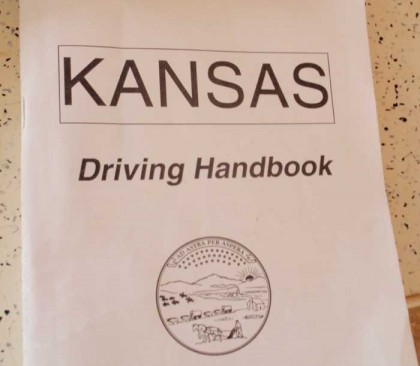Kansas Driving Handbook | PDF
Sponsored Links
The Kansas Driving Handbook is indispensable for Kansas drivers with a comprehensive guide to traffic rules and detailed information about driver’s licenses and driver’s exams. Here is a synopsis of the handbook.
Sponsored Links
Inside the Kansas Driving Handbook

A physical copy of the Kansas Driving Handbook
The longest and most important section, “Rules of the Road,” which covers traffic laws and how to drive in a variety of situations, is the best reference for test takers and seasoned drivers alike. The introduction of the section stresses that driving can be inherently dangerous, and thus drivers have a great responsibility to drive safely. Here are some of the rules from the handbook that will make driving safer:
- Changing lanes: Use mirrors and check your blind spot, then signal, and change lanes gradually.
- Drive in the right lane unless you are passing.
- Enter a turning lane long before your turn, give the proper signal, and do not veer out of the proper lane while turning.
- Slow down before entering curves.
- Passing: You may pass cars on a two-lane road when you can do so safely without speeding and when there’s no oncoming traffic, but not when the solid yellow line is on your side of the road. Do not pass where a hill or curve obstructs your sight ahead, or where there is a no-passing sign.
- Following: Maintain a safe distance when driving behind other vehicles: Using the 2-second rule, count two seconds from when the car in front of you passes an object, and if you pass that same object before the 2 seconds expire, you’re following too closely. At higher speeds or in poor conditions, stay even farther back.
- Backing up: Look in all directions before backing up, and watch carefully to your rear while backing up. Do not use your rear-view mirror—turn your head.
- Right-of-way: Pedestrians always have the right-of-way, so approach intersections with caution. Drivers turning left do not have the right-of-way without a green turn signal.
- Night driving: Always have your lights on when it is not bright outside. Use high beams only when there is no approaching traffic or cars in front of you. Reduce speed in general because night vision is worse.
- Winter driving: Get chains or snow tires, maintain a longer interval between other cars and reduce speed, and look out for icy parts of road.
Then the guide explains the meaning of every traffic sign, including construction signs, and what to do when you encounter each one. It also covers what to do in emergencies, defensive driving, and entering and exiting interstates.
The handbook is especially important for people with upcoming license exams, which consist of vision, written, and driving tests. After passing the vision test and written test, potential licensees will undergo a driving test to measure 15 issues:
- Smooth stopping
- Backing
- Traffic lights
- Stop signs
- Approaching a corner
- Right-of-way
- Using the clutch
- Parking on a hill
- Starting on a grade
- Turning
- Passing
- Keeping in lane
- Using the horn
- Following
- Hand position
Download (PDF, 11.63MB)
Sources
Sponsored Links